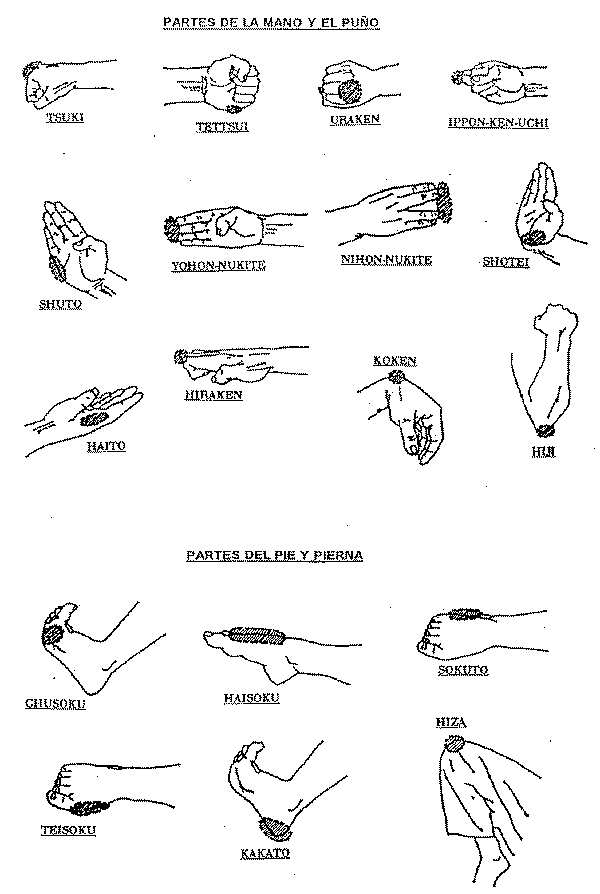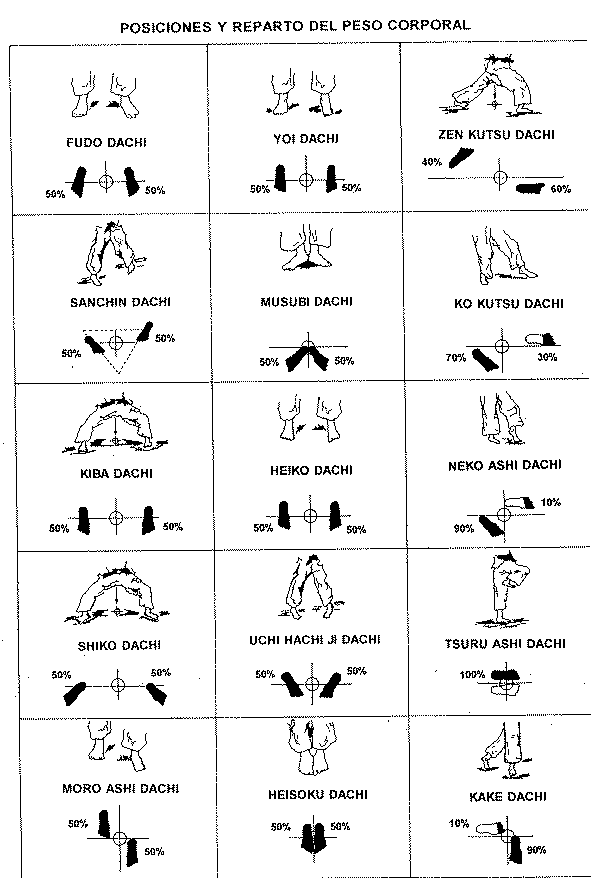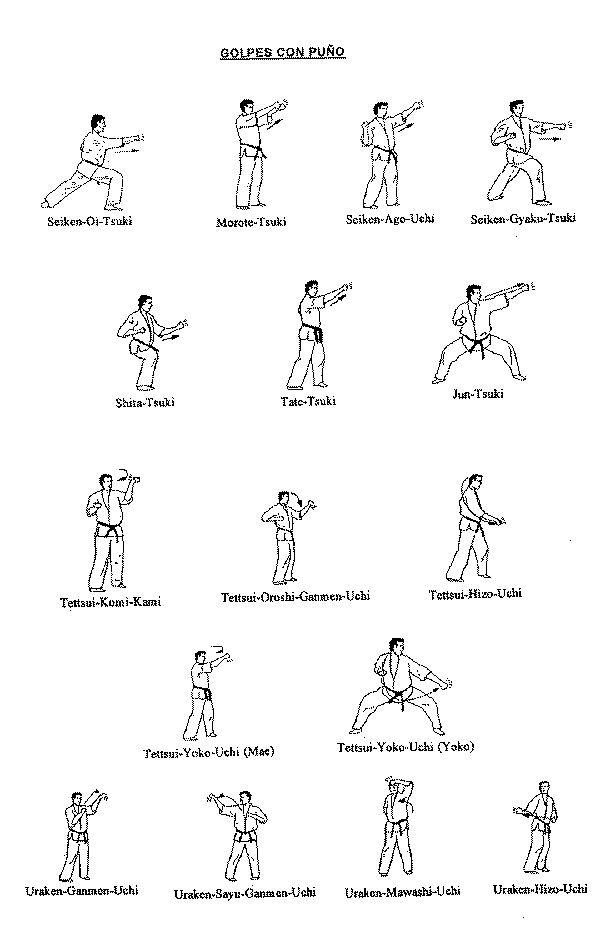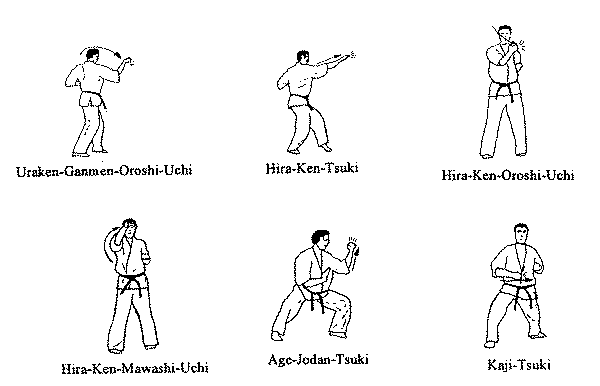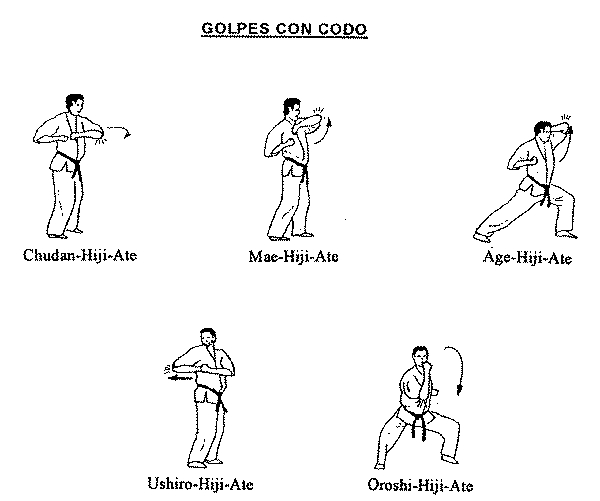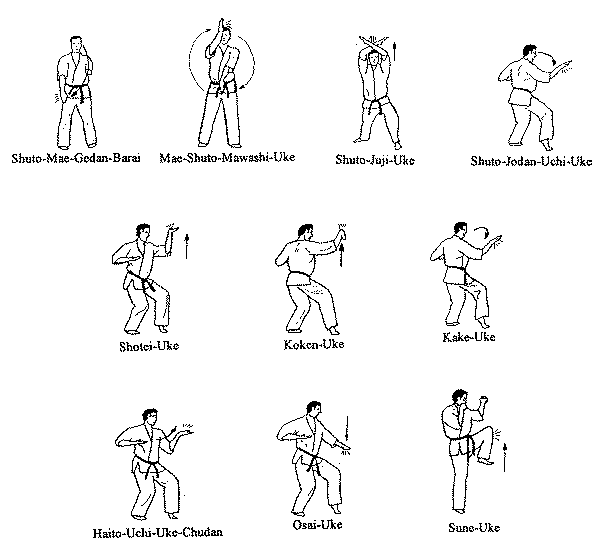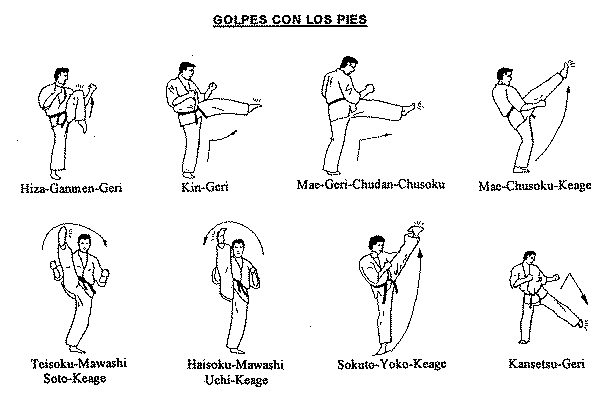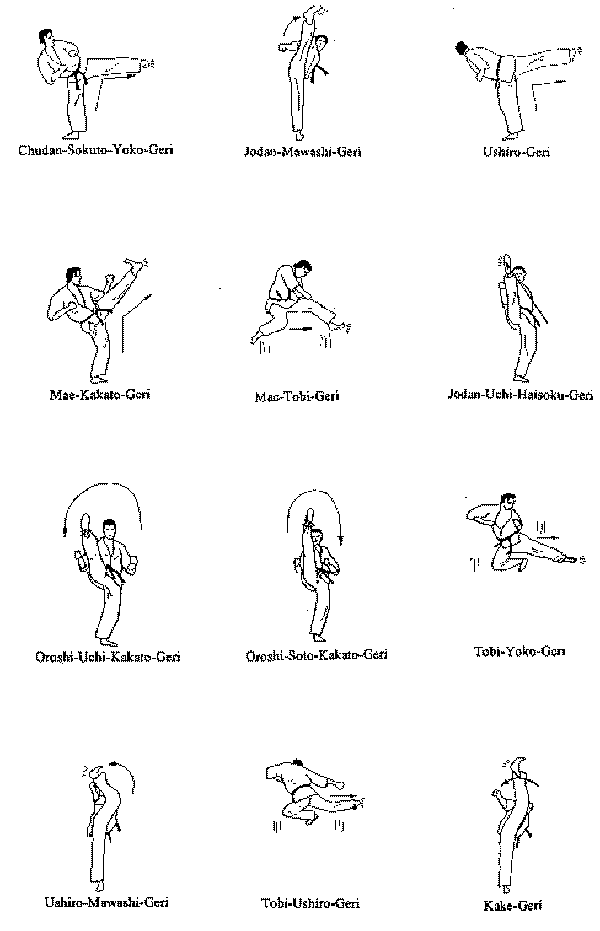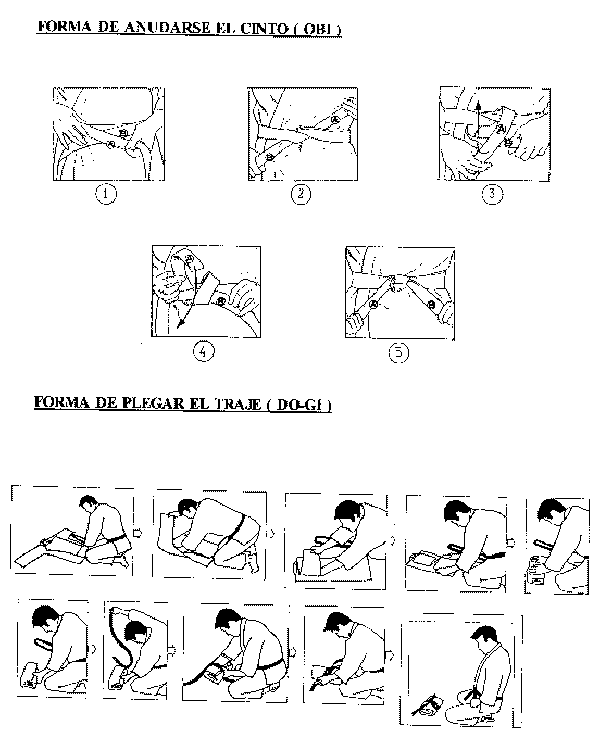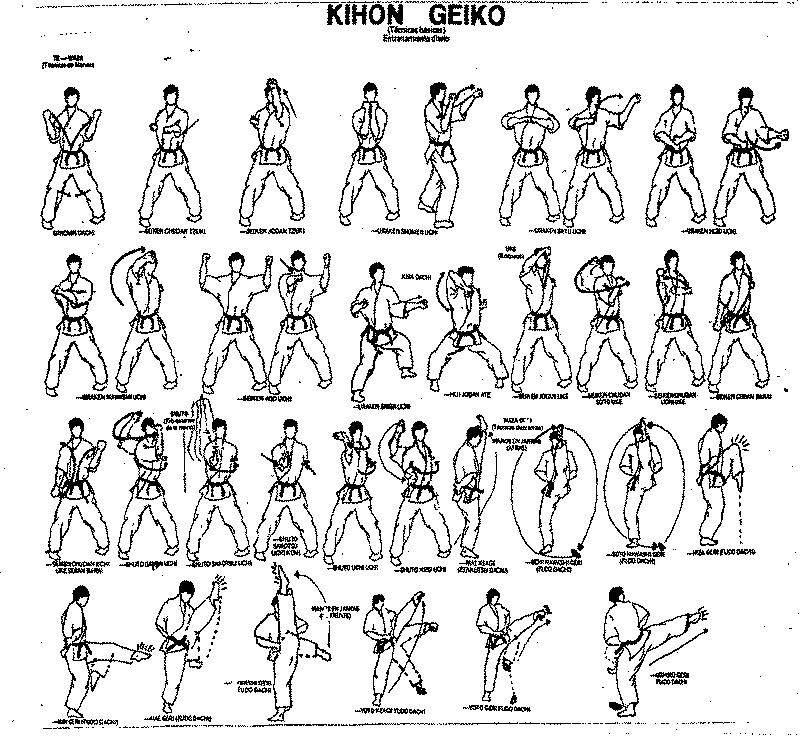The Kihon Geiko presented here is not an official of any Kyokushin Organization it is only a basic representation of what we learn in our school. The grading requirements in our school contain the following:
Theory
Exercises (Body conditioning)
Mind Conditioning (Relaxation, Meditation)
Stances
Blocks
Punches-Strikes
Kicks
Katas
Renraku
Goshin Jitsu (Self defense / Tachiwaza, Newaza, Gyakute...)
Kumite
Tameshiwari
Below there are names of some of the techniques that the students have to learn in order to pass grades.
1) SEIKEN: (NORMAL FIST)
| SEIKEN CHUDAN-TSUKI (MIDDLE PUNCH) | |
| SEIKEN JODAN-TSUKI (HIGH PUNCH) | |
| SEIKEN AGO-UCHI (FAST PUNCH TO THE CHIN) | |
| SEIKEN MAWASHI-UCHI (ROUNDHOUSE PUNCH) |
2) TETTSUI : ( HAMMER FIST )
| TETTSUI KOME KAMI (STRIKE TO SIDE OF THE FACE) | |
| TETTSUI OROSHI GANMEN UCHI (DOWN TO THE FACE) | |
| TETTSUI HIZO UCHI (STRIKE TO THE SPLEEN) | |
| TETTSUI MAE YOKO UCHI JODAN (NAKA UCHI) | |
| TETTSUI MAE YOKO UCHI CHUDAN (NAKA UCHI) | |
| TETTSUI MAE YOKO UCHI GEDAN (NAKA UCHI) | |
| TETTSUI YOKO UCHI JODAN (OVER YOUR SHOULDER) | |
| TETTSUI YOKO UCHI CHUDAN (UNDER YOUR ARM) | |
| TETTSUI YOKO UCHI JODAN (YUYI UKE JODAN FIRST) |
3) URAKEN: (BACK FIST)
| URAKEN SHOMEN-UCHI (FORWARD STRIKE TO THE FACE) | |
| URAKEN SAYU-UCHI (RIGHT-LEFT STRIKE TO THE SIDE) | |
| URAKEN HIZO-UCHI (STRIKE TO THE SPLEEN) | |
| URAKEN GANMEN OROSHI-UCHI (DESCENDING STRIKE TO THE FACE) | |
| URAKEN SHITA-UCHI (INVERTED-FIST LOW TRUST) |
4) HIJI :(ELBOW)
| HIJI JODAN (UPPER STRIKE) | |
| HIJI CHUDAN-ATE (STRIKE TO THE ABDOMEN AND CHEST) | |
| HIJI AGE-UCHI (RISING ELBOW STRIKE) | |
| HIJI OROSHI-UCHI (DESCENDING ELBOW STRIKE) |
5) UKE :(BLOCK)
| SEIKEN JODAN-UKE (HIGH BLOCK) | |
| SEIKEN CHUDAN UCHI-UKE (MIDDLE BLOCK) | |
| SEIKEN CHUDAN SOTO-UKE | |
| SEIKEN GEDAN-BARAI(DOWN BLOCK) |
6) SHUTO:(KNIFE HAND)
| SHUTO GANMEN-UCHI (STRIKE TO THE FACE) | |
| SHUTO SAKOTSU-UCHI (STRIKE TO THE COLLARBONE) | |
| SHUTO SAKOTSU-UCHIKOMI (DRIVING STRIKE TO THE COLLARBONE) | |
| SHUTO NAKA-UCHI (FROM INSIDE TO THE OUTSIDE) | |
| SHUTO HIZO-UCHI (STRIKE TO THE SPLEEN) |
7) KERI: (KICKS)
| MAE-GERI KEAGE (HIGH FRONT KICK) | |
| MAE-GERI JODAN (HIGH FRONT KICK) | |
| UCHI-MAWASHI-GERI (OUTSIDE ROUNDHOUSE KICK) | |
| SOTO-MAWASHI-GERI (INSIDE ROUNDHOUSE KICK) | |
| HIZA-GERI (KNEE) | |
| KIN-GERI (SNAP KICK TO THE GROIN) | |
| MAE-GERI CHUDAN (FRONT KICK) | |
| MAWASHI KUBI-GERI (INSTEP ROUNDHOUSE KICK) | |
| YOKO-GERI KEAGE (HIGH SIDE KICK) | |
| YOKO-GERI (FRONT KICK) | |
| USHIRO-GERI (HORSE KICK) |
|
KATAS |
|||||
|
|
||||
|
|
||||
|
|
||||
|
|
||||
|
|
||||
|
|
||||
|
|
||||
|
|
||||
|
|
||||
|
|
||||
|
|
||||
|
|
||||
|
|
||||
|
|||||
|
|||||
|
|||||
| SOKUGI KATAS :( Kicking Katas ) | |||||
|
|
||||
|
|
||||
| URA KATAS:( Reverse Katas ) | |||||
|
|
||||
|
|||||
| TATE KATAS :( Straight line Katas ) | |||||
|
|
||||
| BO KATAS :( Stick Katas ) | |||||
|
|
||||
When you study the Katas, you should tried to consider all the points below
in order to have a better understanding of all the movements involved in the
different Katas.
.
01. Te Waza (Hand Techniques).
02. Geri Waza (Foot or Kicks Techniques).
03. Uke Waza (Blocks Techniques).
04. Goshin Jitsu (Techniques of self defense).
05. Genkotsu ó Kyusho Jutsu (Vital or pressing points attack)
06. Kanzetsu Waza (Arm bars and joint locking Techniques).
07. Taoshi Waza (Sweep Techniques).
08. Nage Waza (Throwing Techniques).
09. Iki no Chosei ( Breathing control Techniques ).
10. Waza no Kankyu (Ritmo, Tiempo y Cadencia ).
11. Chikara no Kyojaku ( Puntos de Poder y Tensión ).
12. Kime (Focus).
13. Tai Sabaki (Body movement, foot work).
14. Heiho ( Tactics and Strategy ).
15. Ki (Internal energy).
16. Anatomy.
17. Physiology.
18. Point and Circle Theory.
In Japanese and Okinawa Karate there are about 70 Katas (Formal exercises), Kyokushin Karate have around 31 Katas practiced by all Kyokushin groups. Also there are 13 more Katas that Sosai Oyama taught on the beginning of Kyokushin, but later on were left aside. 4 of them were from Shotokan (Naihanchi Ichi, Ni, San, or Tekki 1, 2, 3.) Today some Kyokushin groups are again practicing those Katas and some schools have include them in theirs requirements for grading.
KYOKUSHIN KATAS:
TAIKYOKU ICHI, NI, SAN - OMOTE
First cause - First course. Also, means taking the overview, the large view. See
the whole rather than focusing on the individual parts. According to a
translator of the Karate-Do Kyohan "a philosophical term denoting the macrocosm
before its differentiation into heaven and hearth: hence, chaos or the void".
Taikyoku Katas come from Shotokan and was created by Gichin Funakoshi en 1930.
(Northern Kata)
TAIKYOKU ICHI, NI, SAN - URA
Developed by Sosai Masutatsu Oyama en 1980.
SOKUGI TAIKYOKU ICHI, NI SAN
Kicking Katas
Developed by Sosai Masutatsu Oyama en 1980.
PINAN ICHI, NI, SAN, YON, GO - OMOTE
Peaceful Mind. It means peace and harmony. Though the physical moves of Kata
involve techniques used for fighting, the purpose of Kata is also to develop a
calm, peaceful mind and harmony between mind and body.
Pinan Katas come from Shotokan and was created by Anko Itosu.
(Northern Kata)
PINAN ICHI, NI, SAN, YON, GO – URA
Developed by Sosai Masutatsu Oyama en 1980.
SANCHIN KATA
This is the oldest Kata in Karate-do. Loosely translated, Sanchin means,
three battles, three points, or three phases, a reference to the fact that
Sanchin seeks to develop three elements at a time.
1. The mind, the body, and the spirit.
2. The internal organs, the blood circulation and the nervous system.
3. And the three Ki located in:
a) the top of the head (tento)
b) the diaphragm (hara)
c) and the lower abdomen (tanden)
Karyo Higaonna (Teacher of Chojun Miyagi, founder of Goju-Ryu) bring it from
China.
According to many Okinawan masters Sanchin Kata is based directly on exercises
taught by Daruma. These are Ekkin Ki(tendon transforming Ki exercise) and Senzui
Kiko (Marrow cleansing Ki exercise). The first set (Ekkin Kiko) focuses on first
circulating Ki through the primary meridians then through the whole body. As
this is done, the muscles and tendons are strengthened and stretched. The Senzui
Kiko stresses leading the Ki into the bones and up the cerebrospinal system.
(A Southern Kata, inherited from Goju Ryu).
TENSHO
Means flowing hands or rolling hands.
Chojun Miyagi, created this Kata after a deep study of the Chino Rokkishu
Kata, and as a complement for the Sanchin Kata.
(A Southern Kata, inherited from Goju Ryu).
YANTSU
Means Safe Three, said to be the name of a 19th century Chinese military
attaché to Okinawa and sometimes translated as "To maintain purity", striving to
maintain the purity of your principles and ideals, rather than compromising for
the expedient. Generally it is only found in Kyokushin derived styles and in
Chinese Kempo schools where it probably originated.
(Northern Kata).
SAIFA - SAIHA
Means Tearing or big wave, stands for the principle that no matter how large the
problem that faces you, with determination and a strong bushido spirit you can
break through. It is the Chinese origin, brought back to Okinawa by Kanryo
Higaonna.
(A Southern Kata, inherited from Goju Ryu).
TSUKI NO KATA
Punching Kata. Means Fortune and luck. Good fortune does not come simply by
waiting. Each time we punch,in this Kata, we should imagine that we are breaking
down some barrier. Strong, persistent effort directed at our problems will bring
us good fortune.
Origin unknown, probably from Shotokan
(Northern Kata).
GEKSAI DAI / GEKSAI SHO
Means Conquer and occupy. Also means to Destroy or Demolish. Dai means large and Sho means small, this labeling
is simply an alternative to using numbers. Sai means fortress or stronghold,
Geki means breakdown. Kata teaches strength through motion and the utilization
of combinations, mobility and fluidity. Flexibility of attack and response will
always be superior to, and thus defeat, rigid and inflexible brute strenght.
Creada por Chojun Miyagi (Goju-Ryu founder) in 1940.
(A Southern Kata, inherited from Goju Ryu).
SEIENCHIN (La Tormenta dentro de la calma)
(A Southern Kata, inherited from Goju Ryu).
SEIPAI (18 Hands)
(A Southern Kata, inherited from Goju Ryu).
KANKU
Viewing the sky.
This Kata is also known as the "Rising Sun". Literally, Kan means good
observance and Ku means universe or air or emptiness. The opening move of the
Kata is the forming of a triangle above the head. We form the triangle with our
hands, and we lean back and stare through it toward the universe and the rising
sun. The significanse is that no matter what problem or dilema you may face,
each day the sun rises anew and the universe is before you. Nothing is so
terrible that it affects the basic reality of existence. As long as you are here
and the sky and the sun are before you, you are never
defeated.
This Kata was Introducido en Okinawa en 1756. The Okinawa name is Kushanku
(Chinese name of the creator).
(Northern Kata).
GARYU
Means reclining dragon. It was created by Sosai Masutatsu Oyama. Garyu was the
pen name of Sosai Oyama, in his early Karate life, and represents the
humility of a reclining dragon that has power but chooses not to release it.
(Southern Kata).
SUSHIHO
Means literally 54 steps. Originates from Shuri-te Okinawan schools, which were
heavily Northern Chinese influenced. There may have been a link between the name
and the original form of this Kata, and the number 54 has close links to
Buddhist philosophy.
This Kata is a
variation of Gojushiho Dai
(Northern Kata).
![]()
